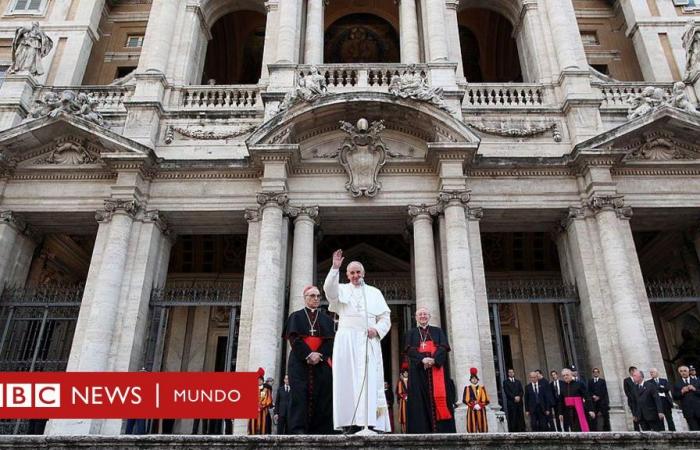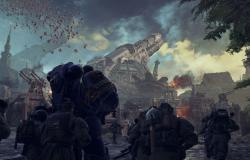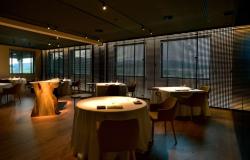Image source, Getty Images
- Author, Juan Francisco Alonso
- Author’s title, Special Envoy to Rome, BBC News world
-
2 hours
San Juan Pablo II was qualified as the Pope of the records, because it was the one who made the most apostolic trips (104), more encyclical documents, exhortations and books published (90) and more holy led the altars (483) in his 27 years on the throne of St. Peter. Francisco, meanwhile, was the Pope of the first times.
Jorge Mario Bergoglio, who died on April 21 at age 88, was the first leader of the Catholic Church born in South America, the first Jesuit and also the first to use the name of Francisco, in tribute to the radical San Francisco de Asís (1181-1230), to identify.
And in his 12 years of pontificate he broke other customs: he was the first Pope who lived outside the Apostolic Palace, the first to visit countries like Iraq and the first to sign a statement of fraternity with Islamic authorities. And with his death he wanted to mark another precedent: the Argentine pontiff will be the first in a century that will not be buried in the caves of the Basilica of San Pedro.
Francisco decided that his last abode is the basilica of Santa María la Mayor, also in Rome, about 6 kilometers away from the Vatican.
“I want my last earthly trip to end precisely in this former Marian sanctuary, where I always stop to pray at the beginning and end of each apostolic trip, trusting my intentions to the immaculate mother and giving thanks for her sweet and maternal care,” reads the testament of the pontiff.
Image source, Getty Images
One of the four great
Santa María la Mayor is one of the four papal basilic in the Italian capital.
It is a huge building whose origins date back to the fourth century.
According to the tradition, Pope Liberio (36th Roman Pontiff) ordered the church to be built at the site where an unusual snowfall occurred in the middle of summer, after the Virgin Mary had appeared to a patrician marriage.
And although in San Pedro hierarchy it is the most important Catholic temple, not only for its size, but because it is believed to be on the tomb of the first Pope -the apostle Peter -some faithful consider that with Francisco’s decision, Santa María la Mayor will gain relevance.
“The Basilica of San Pedro is the most important of the Catholic Church worldwide, but now Santa Maria is going to be the second, because here is Pope Francis, the Holy of Mercy,” he told BBC Mundo from the outside of the Irene Coronado temple, a Guatemalan resident in the United States that is in Rome.
Santa María la Mayor is different from other churches, because it is one of the few that has no cross shape, but retains the shape of the Pagan Roman temple on which it was raised. Originally it was a sanctuary in honor of the goddess Cibeles.
Image source, Getty Images
Also, its rich and elaborate internal decoration allows the visitor to make a trip through the past, from the Byzantine time to the Baroque.
The mosaics that coat the walls and the ceiling artison are made with gold extracted from America by the Spanish crown. There are even those who claim that the precious metal lot was carried by Christopher Columbus himself.
On the other hand, the most faithful and believers will find beautiful relics, among which the five timber that is affirmed were part of the cradle where Jesus was in his first days of life in Bethlehem.
The tables are inside an elaborate rock crystal reliquary, with gold and bronze, which is at the foot of the main altar.
“The timbers have been scientifically dated as belonging to the period of their birth (of Jesus Christ),” Andreas Raub, a historian of the art of the basilica, told BBC Mundo.
Francisco will join seven other potatoes that already rest in the temple, among whom San Pío V (1504-1572), whose body is exhibited in the so-called Sistine or Nativity chapel in a glass urn where his body can be seen 453 years after deceased, although his face is covered with a silver mask.
This was the pontiff who excommunicated Queen Elizabeth I of England (1533-1603).
Another Pope who is in the Basilica is Clemente IX (1600-1699), who beatified Santa Rome of Lima, the first Saint of Latin America.
Sixto V (1521-1590), Clemente VIII (1536-1605), Nicolás IV (1227-1292), Honorio III (1150-1227) and Pablo V (1550-1621) are the others.
But in addition to the church bosses, illustrious figures such as the sculptor and architect Gian Lorenzo Bernini (1598-1680), author of the famous colonnade of the Plaza de San Pedro; and Paulina Bonaparte (1780-1825), sister of the French emperor Napoleon Bonaparte (1769-1821).
Image source, Getty Images
A deep connection
Pope Francis’s relationship with the Basilica is long data and not even his convalescence for the bilateral pneumonia he suffered in his last weeks of life interrupted.
-On March 23, just being discharged from the Gemelli Hospital in Rome, he went through the temple to leave Cardinal Rolandas Makrickas, a coadjutor arciprest, a bouquet of flowers.
The Argentine pontiff, who did not get off the Fiat 500 in which he was traveling, handed over the flowers to the flowers to place them before the icon of the Virgin, known as Safety of the Roman people (The protector of the Roman people).
And, then on April 12, Bergoglio returned to pray before the Byzantine icon of the Virgin Mary, nicknamed as Our Lady of the Snow, which, according to tradition, was painted by the Gospelist Luke on a piece of the table where Jesus celebrated the last dinner.
“The Pope came here since his time as a bishop in Argentina. He was very devoted to the Safety of the Roman people“One of the priests of the Basilica told BBC Mundo.
“The Pope himself chose the place where he wanted to be buried,” said the religious while blessed after the other the rosaries, crucifixes and stamps that put the hundreds of faithful and tourists who this week have filled the enclosure.
Image source, Getty Images
In an interview with the Spanish Vaticanist Javier Martínez-Brocal, who appears in the book “The Successor”, published in 2024, Francisco indicated where he wanted his remains to be placed.
“Just after the sculpture of the Queen of Peace (the Virgin) there is a small enclosure, a door that gives a room that they used to keep the candlesticks. I saw it and thought: ‘That is the place’. And the place of the burial is already prepared there. They have confirmed that it is already ready,” Francisco said, according to the book.
In the route that BBC Mundo carried out through the temple we could see an area covered with tables between the so -called Paulina chapel, where the altarpiece of the Safety of the Roman peopleand the Sforza chapel, which was designed by the famous artist Miguel Ángel.
“This is where they are going to bury the Pope,” a woman told her son and husband, while taking a picture next to the wooden fence.
The place receives more public since it is known that Francisco asked to be buried there “on the earth, simple, without particular decoration”, with the inscription “Franciscus”, his papal name in Latin.
“We were in a restaurant when they told us that the Pope will be buried here and that is why we came to see this site, because this is something historical,” said Costa Rican Christian Vintas, while asking a partner from the airline for which he works to take a photo in front of the temple.
Image source, Juan Francisco Alonso/BBC
With his order, his country and Spain
The link between the late Pope and the Basilica of Santa María la Mayor has other explanations.
In the temple he celebrated his first Mass, at Christmas of 1538, San Ignacio de Loyola, founder of the Society of Jesus, better known as the Jesuits, the religious order from which Francisco came.
Likewise, the Basilica is a few meters from the Argentine Embassy in Rome, which has been operating on that site since 1889; And since last year this temple is “added” (twin) with the Metropolitan Cathedral of Buenos Aires by order of the missing Pope.
However, these gestures did not serve as comfort for any of Francisco’s compatriots, who resent that he has not traveled his native country during his pontificate.
“The penalty we have as Argentines is that he never visited us. Juan Pablo II visited us twice and he was Argentine,” he complained to BBC Mundo Carlos Asura, a neighbor of Bahía Blanca (province of Buenos Aires), who was on vacation with his wife in Italy when Francisco died.
Image source, Juan Francisco Alonso/BBC
But the basilica also has links with Spain for centuries. In 1647, the Spanish king Felipe IV became one of the greatest benefactors of this temple and, therefore, the royal house of the European country obtained honorary charges.
“By former privilege, His Majesty The King of Spain is the Honorary Canonical Proto of the Liberian Cabildo (an instance that governs the Basilica of Santa María la Mayor),” says the Basilica website.
The link is maintained until today. And all thanks to a document signed in 1953, by the then Pope Pius XII (1878-1958), which was attached to the concordat between the Vatican and Spain, then governed by General Francisco Franco.
This instrument establishes that Santa María la Mayor must make three annual celebrations for Spain and also contemplates that there will always be a canon of Spanish nationality in the temple.
The singular and peculiar Roman basilica will be, since this weekend, the last abode of the pontiff that came from “the end of the world”, as he described himself.
Image source, Getty Images
Subscribe here To our new newsletter to receive every Friday a selection of our best content of the week.
And remember that you can receive notifications in our app. Download the latest version and act.






